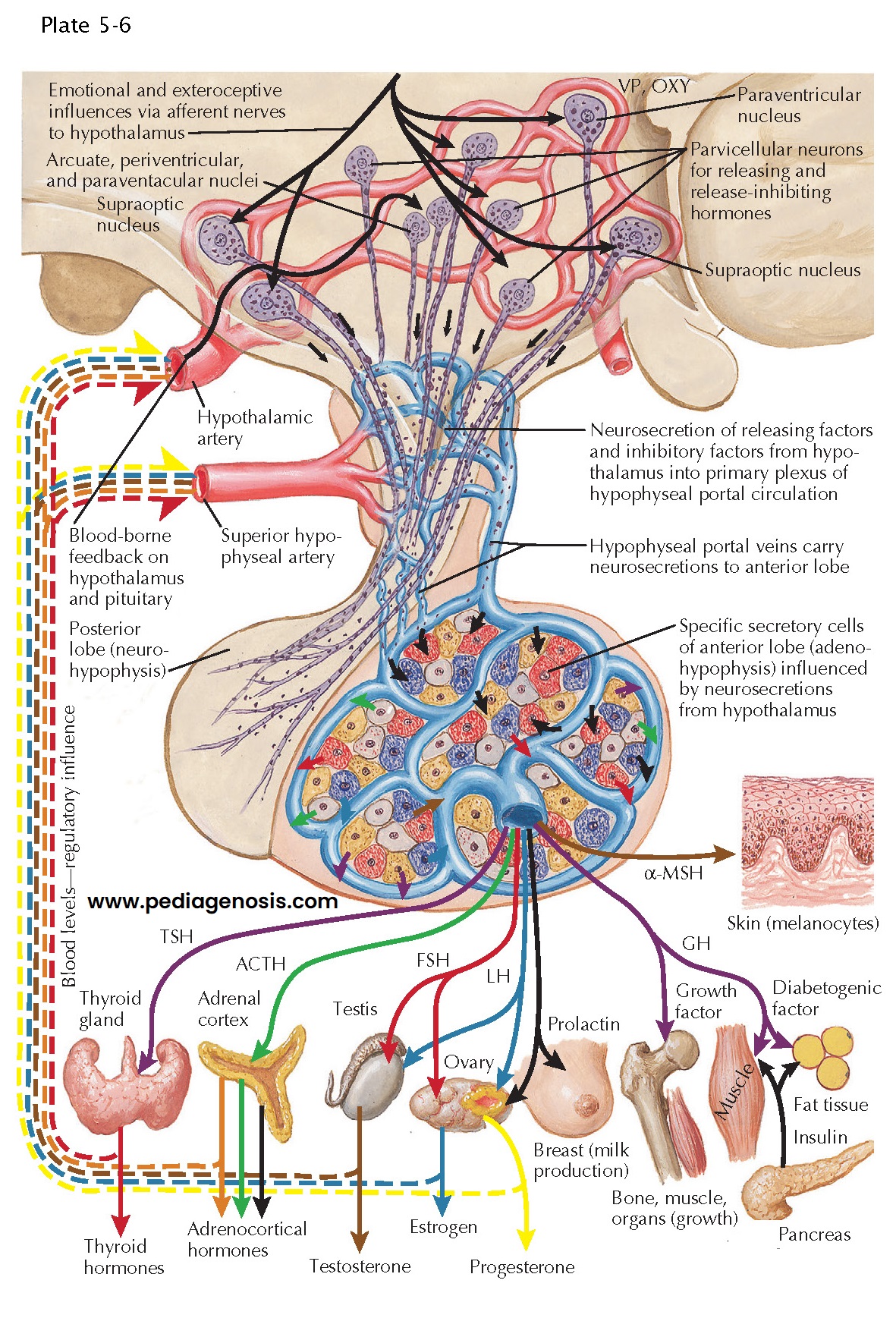Hypothalamic Control of the Pituitary Gland
The hypothalamus contains
two sets of neuroendocrine neurons, the magnocellular neurons, which send axons
to the posterior pituitary gland, and the parvicellular neurons, which secrete
releasing or release-inhibiting hormones into the pituitary portal circulation.
 |
| HYPOTHALAMIC CONTROL OF THE ANTERIOR AND POSTERIOR PITUITARY GLAND |
The magnocellular neurons consist of two clusters: the supraoptic and paraventricular nuclei. Each cell group contains both oxytocin (OXY) and vasopressin (VP) neurons. These cells secrete the hormones from their terminals in the posterior pituitary gland into the general circulation. Vasopressin controls urinary water and sodium excretion, as well as having direct vasocon- strictor effects on blood vessels. Oxytocin has some vasoconstrictor properties and causes uterine contrac- tions but also is involved in the milk let-down reflex during suckling. Cutting the pituitary stalk causes loss of secretion of both hormones, but the predominant symptom is diabetes insipidus, due to lack of vasopressin. Such individuals have excess loss of water in the urine, requiring the ingestion of up to 20 liters of water per day to maintain blood osmolality in the normal range, unless the hormone is replaced.
The
parvicellular neurons are located along the wall of the third ventricle in the
periventricular, paraventricular, and arcuate nuclei. Different populations of
parvicellular endocrine neurons, secreting specific pituitary releasing or
release-inhibiting hormones, have characteristic locations within this region.
The corticotropin-releasing hormone neurons, which cause secretion of
adrenocorticotrophic hormone (ACTH), and ultimately adrenal corticosteroids,
are mainly located in the paraventricular nucleus. Many neurons that secrete
thyrotropin-releasing hormone neurons, which cause secretion of
thyroid-stimulating hormone (TSH), or somatostatin, which inhibits secretion of
growth hormone (GH), are also in the paraventricular nucleus, but some are
found rostral to it in the periventricular nucleus. Neurons that secrete
gonadotropin- releasing hormone neurons (which cause secretion of luteinizing
hormone [LH] and follicle-stimulating hormone [FSH]) are found in the most rostral
part of the periventricular nucleus and dorsal arcuate nucleus. The rostral
part of the arcuate nucleus also contains growth hormone–releasing hormone
neurons. Neurons secreting dopamine (a prolactin release–inhibiting hormone)
are found widely distributed along the wall of the third ventricle in the
periventricular, paraventricular, and arcuate nuclei. The arcuate nucleus also
contains neurons that express pro-opiomelanocortin (POMC), a precursor protein
that can be differentially processed to produce ACTH (e.g., in the pituitary
gland), but that is processed into α-melanocyte–stimulating
hormone (α-MSH) and β-endorphin in the arcuate nucleus, which uses them as neurotransmitters.
The anterior
pituitary gland contains a mixed population of pituitary cells, each of which
secretes a different hormone: TSH, ACTH/α-MSH, FSH/LH, prolactin, or GH. These hormones as well as their releasing
and release-inhibiting factors can feed back upon the parvicellular endocrine
neurons, providing short loop feedback. Prolactin is the only pituitary hormone
that is primarily under inhibitory tone from the hypothalamus. Hence, when the
pituitary stalk is damaged, the secretion of other anterior pituitary hormones
is diminished, but prolactin increases.
Endocrine disorders may ensue from either excess secretion or lack of secretion of either an anterior pituitary hormone or its hypothalamic-releasing or release-inhibiting hormones. Thus precocious puberty is sometimes seen with hypothalamic hamartomas that secrete gonadotropin-secreting factor. On the other hand, amenorrhea may occur from increased secretion of prolactin. Cushing syndrome—the oversecretion of adrenal corticosteroids—may result from a steroid- secreting adrenal tumor, a pituitary tumor (or some-times a lung or other tumor) that secretes ACTH, or hypersecretion of corticotropin-releasing hormone.




